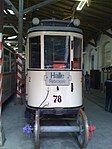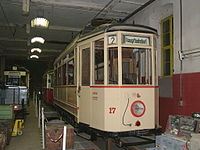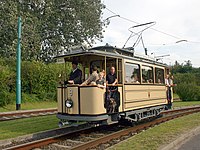Gottfried Lindner AG
| Gottfried Lindner AG | |
|---|---|
| legal form | Corporation |
| founding | 1905 |
| resolution | 1979 |
| Reason for dissolution | liquidation |
| Seat |
Ammendorf near Halle (Saale) (after 1945 Nuremberg ), Germany |
| management |
|
| Number of employees |
|
| Branch | Vehicle construction , body builder |
The Gottfried Lindner AG was a German vehicle construction companies in Ammendorf in Halle (Saale) , which emerged from a founded in 1823 craft shop and structures or bodies for trams, buses , rail cars, trucks and passenger cars produced.
The production facilities in Ammendorf were expropriated in 1945 and formed the VEB Waggonbau Ammendorf from 1952 to 1990 . The name Lindner was retained as a well-known brand for part of the production until 1957. After 1990, the plant came to the Bombardier Group through Deutsche Waggonbau AG (DWA) and was closed in 2005. In 2006, Maschinenbau und Service GmbH (MSG Ammendorf) was founded on the factory premises as a new establishment , which considers itself to be the successor company - but not in a legal sense.
The joint stock company shifted 1945 its seat after Nuremberg . In addition to holdings in other companies, it only owned a few sales and repair branches in the Federal Republic of Germany that were established in the 1930s. In 1965 it went bankrupt , the liquidation was not completed until 1979.
History until 1945
The original cell of the company was a saddler's workshop founded by master saddler Gottfried Lindner in Halle on August 23, 1823 , which was expanded into a cartwright shop for the repair and construction of carriages by around 1830 .
In 1883, the Lindner company began manufacturing carriages for horse trams, and soon also for electric trams. This also set it apart from Ludwig Kathe & Sohn as a local competitor. Of particular importance was the participation in an order for 90 tram cars for the electric tram of the city of Halle in 1889, with Lindner building the car bodies of 45 cars on the chassis supplied by the Herbrand wagon factory .
In 1900 production was relocated from the workshops in Halle to a new factory in Ammendorf.
The family company , which had previously been operated as a general partnership , was initially converted into a limited liability company (GmbH) in 1903 . The further expansion led to the conversion into a stock corporation under the company Gottfried Lindner AG as early as 1905 , initially mostly with the addition of car and wagon factory , and with the seat in Ammendorf. The share capital of originally 600,000 marks was increased to 1.6 million marks by 1912.
1908 began with the production of bodies for passenger cars and buses. Superstructures for commercial vehicles were added later. The production of carriages ended in 1912 after a total production of around 6000 pieces.
During the First World War, production was converted to meet military requirements.
Heinrich Lindner was the general director until 1922 , who was the last member of the Lindner family to leave the company management. In 1922 Hermann Traus took over management and expanded the company to become the largest German bodywork manufacturer at the time.
In 1923 the company was divided into four organizationally independent departments:
- Railroad car
- Tram cars and buses
- Truck bodies and trailer trucks
- Automobile bodies
At that time, the factory site was around 26.3 hectares in size, and the company also owned 115 company apartments.
After the end of the inflation , the share capital was changed from 50 million marks (" paper marks ") to 5 million Reichsmarks . In the Great Depression of 1932 it was reduced to 3.5 million Reichsmarks through the withdrawal of own ordinary shares.
From 1933/1934 onwards, several "branch plants" for sales, maintenance and repair of truck trailers were founded, for example in Berlin, Dresden, Gaggenau, Cologne, Königsberg, Nuremberg and Hamburg. The customer service improved in this way increased sales.
In 1934 Gottfried Lindner AG took a 20% stake in the “Delaport” German load trailer export group based in Hamburg. In 1937, the sales company Perack-Lindner GmbH was founded as a wholly-owned subsidiary . Some of the "branch plants" were converted into formally independent companies in 1938/1939 ( Lindner-trailer sales Berlin GmbH , Lindner trailer sales Dresden GmbH , etc.).
As a result of the dividend tax ordinance of June 12, 1941, the share capital was "corrected" to 8 million Reichsmarks in 1942. In the same year a new vehicle factory was built in Eastern Europe, which was occupied by the Greater German Empire, Lindner-Fahrzeugwerke-Ost GmbH in Białystok .
Tram cars and buses
The production of tram cars began in 1883, and bodies for buses have also been manufactured using the same manufacturing technology since 1908.
No. 78 from 1912 in the Halle Tram Museum
No. 151 in the Museum of Municipal Engineering in Cracow
Railroad car
In 1903 Lindner delivered freight cars to the Prussian State Railways for the first time . With this branch of production, the company participated in 1922 in the sales cartel Eisenbahnwagen-Liefergemeinschaft GmbH (EISLIEG) founded a year earlier . After the Deutsche Reichsbahn-Gesellschaft (DRG) established a new, larger cartel - the Deutsche Wagenbau-Vereinigung - in 1926, to which 90% of the Deutsche Reichsbahn's wagon construction contracts were guaranteed by the so-called Reichsbahn contract, the EISLIEG lost its purpose . Like the other shareholders, Gottfried Lindner AG also joined the new cartel.
Passenger cars
Car bodies for passenger cars have been manufactured since 1908. As in coach building, it was initially mostly a matter of individual productions. After the First World War, the return to the civilian product range took an important step towards rationalization, in that only three basic body shapes were offered and mass-produced (at least 50 units according to the standards of the time). Ultimately, up to 88 bodies were produced per day, mainly open touring cars and limousines , mainly for Adler , AGA , Horch and Protos . All bodies were made in a wood-steel composite construction.
In 1926, the Ambi-Budd company introduced all-steel bodies in large-scale production, which led to a sharp decline in orders for Gottfried Lindner AG. In June 1928, Ambi-Budd-Presswerk GmbH took over the Lindner body department and shut it down in favor of its own production capacity.
Trucks
The manufacture of superstructures for trucks began after 1908. In 1925, Lindner Nutzwagen-Karosserieen-AG was founded with its headquarters in Berlin. Its purpose was to sell the commercial vehicle bodies of Gottfried Lindner AG in Ammendorf near Halle a. S. and sales of automotive accessories were specified. In accordance with the narrowly limited purpose, the share capital was only 50,000 Reichsmarks. General director Hermann Traus represented the interests of Gottfried Lindner AG on the supervisory board .
The construction of truck trailers became more important in the 1930s, when long-distance freight transport by road increased.
Agricultural machines
In the middle of the global economic crisis, Gottfried Lindner AG took over the production of agricultural machines of the Hallensis brand from F. Zimmermann & Co. in autumn 1931 , which continued until the Second World War.
History after 1945
After the Second World War , the factory in Ammendorf, expropriated in 1945, was initially incorporated into the Soviet joint stock company Transmasch in 1946. In 1952 the plant became VEB Waggonbau Ammendorf , which organizationally belonged to VVB LOWA . In addition to commercial vehicle production, which was still under the name Lindner until 1957, until 1990, under the direction of General Director Georg Laschütza, broad gauge passenger cars (so-called long-distance cars) for the Soviet Railways (SZD) and other wagons for other railway companies were produced.
In 1990 VEB Waggonbau Ammendorf was merged with other GDR wagon factories in Deutsche Waggonbau AG (DWA) , which was sold to a private investor group in the mid-1990s. With the resale of DWA to the Bombardier group in 1998, the Ammendorf plant was also integrated into this group. The plant was closed at the end of 2005.
In 2006 the company premises were acquired by the entrepreneur Roland Schimek . In July 2006 the Maschinenbau und Service GmbH (MSG Ammendorf) was established , which sees itself as the successor of VEB Waggonbau Ammendorf and deals with the construction and repair of rail vehicles for domestic and foreign clients. With around 175 employees, MSG is the second largest industrial company in the city of Halle.
Christa Wolf and the circle of writing workers
Between 1959 and 1962, Christa Wolf and her husband Gerhard led the group of writing workers at the Ammendorf Waggonbau plant. Christa Wolf processed her experiences from this time in the story The divided sky .
literature
- Hoff: The German railway system of the present . Reimar Hobbing, Berlin 1923, Volume 2, p. #.
- Handbook of German stock corporations , 30th edition 1925, Volume 2, p. 1863.
- Handbook of German Stock Companies , 37th edition 1932, Volume 2, p. 2006 f.
- Handbook of German Stock Companies , 48th edition 1943, Volume 3, p. 2229 f.
- Werner Oswald : German cars. Volume 2, 1920-1945 . Motorbuch-Verlag, Stuttgart 2005, ISBN 3-613-02170-6 , p. 516. (concise and sometimes misunderstood)
- Christian Suhr: Lindner. Car bodies and trailers from Ammendorf . Reichenbach (Vogtland) / Halle (Saale) 2010, ISBN 978-3-938426-12-8 .
- Sven Frotscher: The steel heart of Halle. Lindner / Waggonbau Ammendorf / MSG. Volume 1: 1823-1945 . Mitteldeutscher Verlag, Halle (Saale) 2014, ISBN 978-3-95462-286-3 .
Web links
- Homepage of the MSG
- Early documents and newspaper articles on Gottfried Lindner AG in the 20th century press kit of the ZBW - Leibniz Information Center for Economics .
Individual evidence
- ↑ Timetable Ammendorf 1900–1919 ( page no longer available , search in web archives ) Info: The link was automatically marked as defective. Please check the link according to the instructions and then remove this notice. (PDF; 125 kB)
- ↑ a b c o. V .: Gottfried Lindner Aktiengesellschaft, Wagen- und Waggonfabrik, Ammendorf b. Halle-Saale . In: Magistrat der Stadt Halle (Ed.): Halle an der Saale . (= Germany's urban development ) 1st edition, Dari-Verlag, Berlin-Halensee 1923, p. 110 f.
- ↑ RGBl. I p. 323
- ↑ Handbook of German Stock Companies , 30th edition 1925, Volume 4, p. 6647.
- ↑ http://www.roland-schimek.de
- ↑ https://www.investieren-in-sachsen-anhalt.de/Sachsen-Anhalt-bringt-Kompetenz-auf-die






